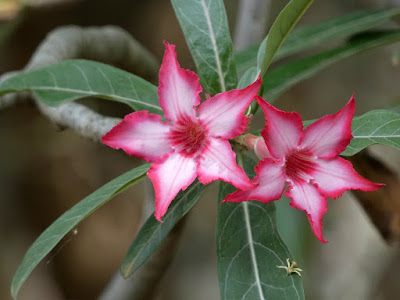Adenium multiflorum is native to central and eastern Southern Africa. It grows at low altitudes in savanna and occasionally open forest, in hot dry areas in sandy places along marshes and rivers, and on brackish flats or rocky habitats at altitudes from 0 to 700 m above sea level...
Adenium multiflorum also called as Impala Lily, Sabie Star, Kudu Lily, Adenium obesum var. multiflorum, is a species of the genus Adenium. This species was described by Johann Friedrich Klotzsch in 1861.
IDENTIFY ADENIUM MULTIFLORUM
Adenium multiflorum is native to central and eastern Southern Africa. It grows at low altitudes in savanna and occasionally open forest, in hot dry areas in sandy places along marshes and rivers, and on brackish flats or rocky habitats at altitudes from 0 to 700 m above sea level.
It is a small, succulent tree, which reaching 0.5-3.5 m high, resembling a dwarf baobab with a stem that arise from a large underground rootstock and have succulent, thick, smooth, with the exception of young apices branches, shiny, gray, with poisonous watery juice bark, that has simple, almost sessile, spirally located at the ends of the branches, leathery, shiny, smooth, the upper side of them is green, the bottom is light, obovate to oblong leaves.
Impala Lily blooms in May to September from dense, apical inflorescences with 5-15 flowers. The flowers are bisexual, spectacular, white, pink, crimson, red or bicolor, with a diameter of 50-70 mm. The flower calyx is 6-8 mm long, pubescent. Sepals are narrow-ovoid, pubescent, fused at the base. Corolla red, pink or white, flower funnel-shaped, 2-4 times longer than calyx, pink or white, with red stripes inside the pharynx. The fruit usually consists of paired, cylindrical follicles up to 240 mm long. The seeds are brown with a tuft of silky hairs.
All parts of the plant are very toxic, so keep it away from the reach of children and pets. With this, this succulents should be handled with care, avoiding direct contact with it, when caring for the plant, gloves should be worn.
ADENIUM MULTIFLORUM CARE AND CULTURE
Cultural information should only be used as a guide, and should be to be adapted to suit you. Your physical location; where you grow your plants, how much time you have to devote to their care, and many other factors, will need to be taken into account. Only then can you decide on the cultural methods that best suit you and your plants.
Light:
Adenium multiflorum needs a bright but diffuse light, remembering that the caudex is very sensitive to sunburn. In the shade, the plant stretches and blooms badly.
Temperature:
It is sensitive to minus temperatures. When growing indoors, the minimum temperature in winter should not be below 10 ° C. With a sudden change in temperature, the plant can partially relieve foliage.
Substrate, growing media and repotting:
This plant should be planted in a pot with large drainage holes on the sides and on the bottom, filled with a very porous loose soil. To obtain such a substrate, add pumice, perlite, sand or brick crumb to a normal soil mix or cactus primer. When planting, care must be taken that the main part of the roots is below the caudex line.
Do not take too deep a pot, this can provoke the drawing of the underground part of the caudex. The repot should be carried out often, until the plant reaches the desired size.
Watering:
Watering is better done in the early morning. Water should be poured until the soil is well saturated with moisture and water begins to flow from below. During the growing season, watered as it dries, not allowing the soil to dry out too often, otherwise this succulents will prematurely hibernate. Watering in the winter very rarely.
Fertilizer:
In order for the plant to develop a powerful caudex and abundantly flowering, it needs regular fertilizing, rich in potassium, phosphorus and trace elements, but with a low nitrogen content during active growth.
Rest period:
Adenium multiflorum comes from arid regions and has a long period of rest. Regardless of the growing conditions at the beginning of winter, the leaves fall off the plant, and in spring the growth resumes. Wintering is dry and cool, at a temperature of 10 ° C.
Trim:
The appearance of the plant depends on the pruning. In order for the plant to form numerous branches, it is better to cut off the leaves. Trim and pruning done once a year during the growing season. Winter pruning usually does not allow you to get a strong branching.
Bonsai:
Adenium multiflorum is suitable for bonsai. It grows relatively fast, so that the seedling can transform into an original bonsai in about five years. Many specimens develop large twisted roots of an interesting shape. Branches can be formed using wire and cut or pinch their growing tips to make the plant branch and maintain a compact appearance.
Diseases and pests:
This plant is sometimes attacked by aphids, mealy worms, scabies. It is especially susceptible to spider mite infestation.
Reproduction:
Adenium multiflorum is propagated by seeds, graft or cuttings. Seeds are sown in the spring, spreading superficially on a special soil mixture for germination. Seeds easily germinate at a temperature of 30 ° C in about a week. Seedlings do not require special care and during the first winter season grow without a period of rest. Next winter, the plant is kept dry to prevent rotting of the fragile root.
Numerous hybrids are propagated mainly by grafting on rootstocks obtained from seedlings. Plants grown from seeds, most often at a young age develop a powerful caudex. Cuttings spend best in the spring. It is necessary to cut off the tip of the shoot, dip the tip into the rooting hormone and allow the slice to dry for one or two days. Then the cuttings are planted in a pot with a bottom heated, filled with coarse-grained soil mixture. The soil must be kept moist.

















COMMENTS